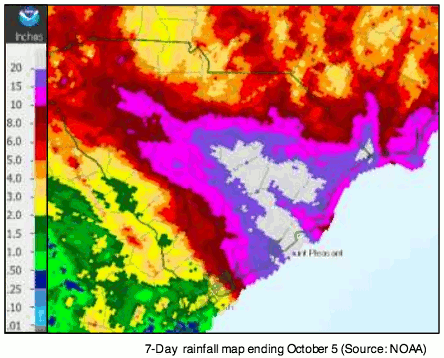Reinsurance broker Aon Benfield’s risk modelling unit Impact Forecasting believes that the “epic weekend rainfall” in South Carolina and elsewhere across the region will result in economic losses that will “easily exceed” $1 billion.
Calling the rainfall event a 1-in-1000 year occurrence, the brokers report also highlights that it is expected that most of the residential damage from flooding will not be covered by insurance. South Carolina has just 200,000 National Flood Insurance Program (NFIP) policies in place, clearly demonstrating the need for a more workable, private market flood insurance solution.
“Given the ongoing nature of the event, it remains too preliminary to provide a specific economic loss estimate at this time. However, given the enormity of the event and the scope of damage incurred to residential and commercial exposures, vehicles and infrastructure, it is expected that overall economic damage will easily exceed USD1.0 billion,” the report explains.
Total storm rainfall totals exceeded 20 inches in many areas over a number of days in South and North Carolina, causing rivers to burst banks, flash flooding inundation, closing roads and knocking out power to many.
Aon Benfield explained the meteorological event that caused the historic rainfall and flooding:
The consecutive days of rainfall from October 1-5 were first preceded by nearly one full week of heavy rains in the last week of September. Some areas of the Carolinas and Mid-Atlantic recorded up to 10.00 inches (254 millimeters) that left soils already very saturated before this recent stretch began.
The current event was caused by a complex atmospheric pattern that led to nearly constant rainfall in parts of coastal South Carolina for a remarkable 72 hours. The surface, mid-, and upper-level weather maps were dotted with an initial stationary frontal boundary that extended along the coastline of the Carolinas. A surface area of low pressure would eventually develop along this boundary, in addition to a strong upper level area of low pressure that was situated over the Southeast. Complicating matters was a ridge of high pressure in the Atlantic Ocean and an even stronger ridge in eastern Canada that helped initiate a strong east to northeast flow and gusty winds. This atmospheric set- up led to an extreme influx of moisture from the Atlantic Ocean that was also partially tapping moisture associated with Hurricane Joaquin.
All of these features worked in tandem to create an atmospheric river-like pattern that brought days of rains “training” over the same areas for several days. It is also conceivable to consider that El Niño may have played a role given that it may have boosted the amount of water vapor available. Precipitable water values would have already been very high even without any added push from the existing El Niño.
What resulted was record rainfall throughout South Carolina. Many one-day, two-day, three-day, and five- day records were established across the state – including in areas around Charleston and the capital city, Columbia. In fact, Columbia, SC set an all-time one-day rainfall record on October 4 with 6.87 inches (174.5 millimeters). The 16.60 inches (421.6 millimeters) of rain that fell in the Gills Creek, SC region on October 4 was the most rain recorded at one spot in a calendar day in more than 16 years. In September 1999, rains associated with Hurricane Floyd dumped 18.30 inches (464.8 millimeters) in Southport, NC.

The final economic impact is likely to rise much higher than $1 billion, but with the U.S. NFIP arranging much of the residential flood insurance the impact to the insurance or reinsurance industry will be lower.
Some commercial insurance policies will include flood insurance coverage, which could result in some insurers with high concentrations of policies in the region facing a reasonable amount of claims. It’s hard to estimate whether there could be a hit to any reinsurance layers, but if there is it will likely be minimal.
Much of the residential economic loss will end up being picked up by homeowners themselves or the government, again highlighting the need for a workable private market flood insurance program in the U.S.
With so much capacity available and wanting to be put to work in insurance, reinsurance and insurance-linked securities (ILS) markets, the time to create a solution to the U.S. flood insurance issue is surely now.
 View all of our Artemis Live video interviews and subscribe to our podcast.
View all of our Artemis Live video interviews and subscribe to our podcast.
All of our Artemis Live insurance-linked securities (ILS), catastrophe bonds and reinsurance video content and video interviews can be accessed online.
Our Artemis Live podcast can be subscribed to using the typical podcast services providers, including Apple, Google, Spotify and more.































